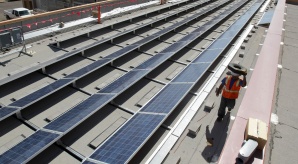Arizona school district goes solar
 Students at the four Agua Fria Union High School District campuses in Avondale, Ariz., will be able to measure the effectiveness of new solar photovoltaic panels while shielding their cars from the hot sun by this September.
Students at the four Agua Fria Union High School District campuses in Avondale, Ariz., will be able to measure the effectiveness of new solar photovoltaic panels while shielding their cars from the hot sun by this September.
The school district teamed with Clean Energy Constructors to install solar panels and has signed a 25-year fixed-rate contract with Clean Energy to buy its power. The solar panels, which will be installed on the roofs of the schools and shade structures for students at lunch and for student and staff parking areas as well as bus-waiting stations, will provide about 40 percent of the school district’s energy needs.
“Since we’ve been able to lock in our rates, it’s going to save us a substantial amount in energy costs over the next 25 years,” said district superintendent Dr. Dennis Runyan.
The district, which only consists of high schools and only manages four campuses total, had already installed solar panels at two of its locations.
“After this expansion, each of our four campuses will have a major solar project,” Runyan said.
Arizona is in a good location for solar energy development, Runyan said. And the school district had a lot to benefit from getting panels at its campuses.
But schools aren’t in a position to make major capital investments for solar right now. That’s why arrangements like this one with Clean Energy Constructors make sense.
The company owns and operates the panels and gets all of the applicable tax rebates and incentives for clean power installations. The company spent about $20 million installing panels for Agua Fria, according to a press release. But in exchange for the land and space the school district provided, the company contracts set energy rates over the next several years.
The fixed rates are not only lower than current rates, but also provide the district with stability, so it won’t have to adjust the energy budget dramatically each year and there won’t be any surprises.
“There’s also an academic bonus to this,” Runyan said. “This precise data generated from the panels on the two roofs we have now goes to these kiosks in the lobby where students can monitor the production and engage with the technology.”
School districts around the country have started installing even small solar arrays for educational purposes.
“This is a very visible and very positive experience,” Runyan said. “We’ve enjoyed the process.
Photo by Deirdre Hamill for the Arizona Republic.



